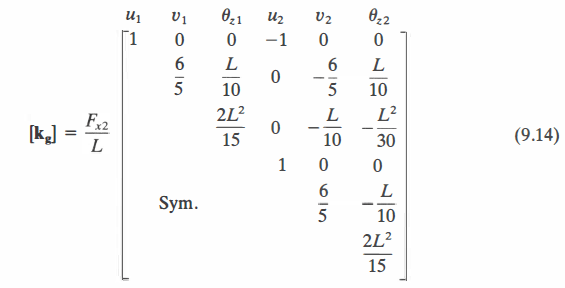A quick and convenient way to allow for the effect of deformations on the behaviour of beams and columns under axial load is to adjust the beam stiffness matrix, so that the calculated deflections are in equilibrium with the applied loads, including the eccentricity of the axial load due to the transverse deflections. Further background to this approach is presented in the book linked in the previous post: Matrix Structural Analysis.
The geometric stiffness matrix for a 1D beam (from the link above) is:
I have incorporated this approach into a spreadsheet that will calculate deflections, shear forces and bending moments for a beam subject to combined axial load and a uniform transverse load. The spreadsheet, including full open source code, may be downloaded from:
Geom_K.zip
Note that the spreadsheet uses the Strand7 axes convention, which changes the sign of some of the matrix values:
Input and output for the Axbeam function is shown below. The beam may be subdivided into any number of segments, each of which may have different materials properties. Deflections or shear forces and bending moments are output at the end of each segment.
Typical input and output is shown below for a beam with 16 segments, and 2 different material properties. Results are shown for an axial load of 1000 kN, and also 1800 kN, which is close to the buckling load:
Output deflections are shown below for the two load cases, compared with results for the same beam in Strand7. For the lower load the results are almost identical. For the higher load the iterative procedure used in Strand7 has resulted in significantly smaller deflections:
A similar trend is seen for bending moments and shear forces:
The MaxDefAx function returns the maximum absolute deflection for a series of axial loads. In the example below the beam has the same EI value over the full length. It can be seen that the predicted buckling load matches the Euler buckling value very closely:
The beam end conditions may be adjusted. In the example below the moment fixity has been removed at both ends. The spreadsheet buckling load again matched the Euler value almost exactly (the maximum value in the table has been reduced below the buckling load, to show the shape of the deflection curve more clearly). When one or more end fixities are released, end loads may be applied to that freedom.










Thanks for your blog. I am not in the field o beams and things but sense a strong kindred spirit in the way you do things that aligns with my own.
Your recent post on IEEE754 numbers really hit a chord for me.
Thanks for that – HAVE BEEN LOOKING FOR THAT TIP FOR YEARS.
I am a mac excel user so some of the stuff you do does not come across.
Would love to be able to speed up my vba using some of the xlwings approach
But this not available to me on Mac.
But wonder how much faster things can get compared to standard vba
Cannot fin any definitive answers to that.
Wonder if you have some material that might be used in a blog article Doug
So keep up the good work – yiou are an inspiration
Bob J.
LikeLike
Thanks for the kind words Bob.
Regarding using xlwings on a Mac, it is possible but the Mac version doesn’t support UDFs.
The speed benefit actually comes from using the compiled functions available in Numpy and Scipy, and similar. Python itself is very slow, even slower than VBA in my experience, but if you have to do something like solving a large matrix equation, using Numpy or Scipy the speed-up can be huge, typically 10-50 times faster.
LikeLike
Hello!! There is any way to download it again, the link seems to be broken. Thanks a lot for your work, Frame4 spreadsheet helped a lot. I am working in frame calculations and this sure could help on the deflection calculation approach.
Happy new year!
Rob.
LikeLike
I have updated the link and converted to a zip file. Please let me know if it works know.
LikeLike
Pingback: Beam geometric non-linear effects – Python version | Newton Excel Bach, not (just) an Excel Blog